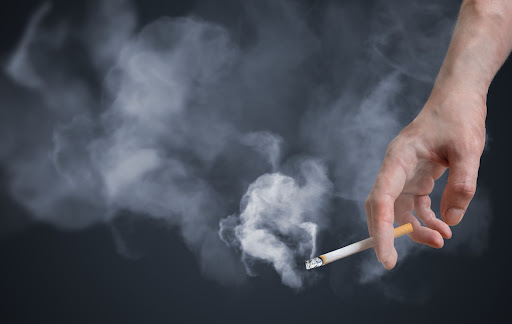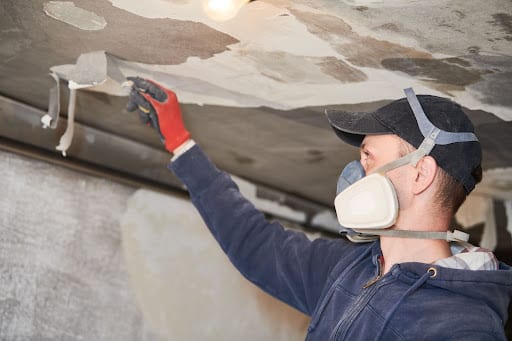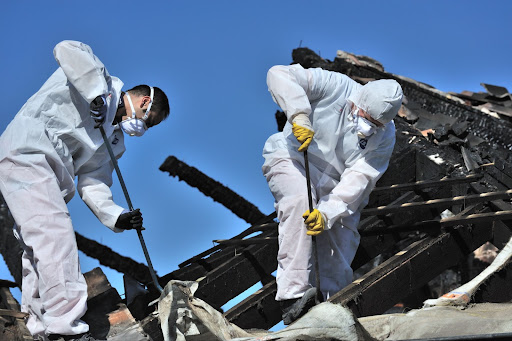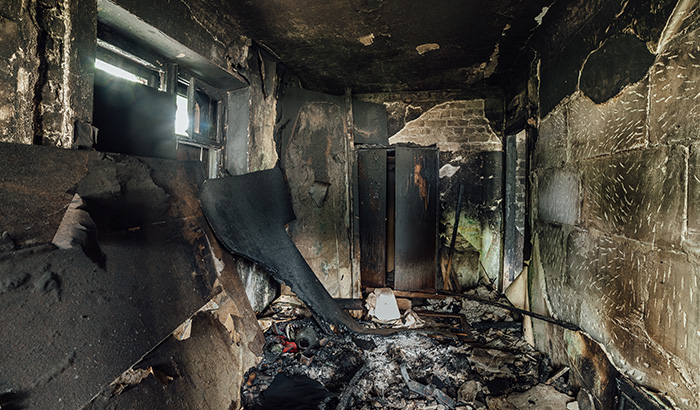Smoke damage can be a distressing and overwhelming issue to deal with in your home. Whether it’s the result of a minor kitchen mishap or a larger-scale fire incident, addressing smoke damage promptly and efficiently is crucial to preventing further deterioration and ensuring the safety and comfort of your living space.
Dealing with smoke damage in your home requires a meticulous and comprehensive approach to ensure that every aspect of the restoration process is handled effectively. From the initial assessment to the final steps of reoccupation and prevention, each phase plays a crucial role in restoring your living space to its pre-damage condition.
This article will show you a comprehensive timeline that will guide you through assessing and repairing smoke damage in your home, providing detailed insights into each stage of the journey.

But first, we will go over the most common causes of smoke damage:
Smoke damage can result from various incidents, both minor and catastrophic. The causes of smoke damage vary, ranging from household accidents to larger-scale fire emergencies. Understanding the common causes and their specific details is essential for prevention and preparedness.
1. Cooking Accidents: Cooking accidents are among the most frequent causes of smoke damage. Unattended pots, overheated oil, or food left on the stove can lead to smoke and subsequent damage. The smoke produced can spread quickly, leaving a residue on surfaces, walls, and ceilings.
2. Electrical Fires: Electrical fires often originate from faulty wiring, overloaded circuits, or malfunctioning appliances. The resulting smoke can be thick and toxic, leaving visible residue and potentially harmful particles that require thorough cleaning.
3. Heating Systems: Malfunctioning heating systems, such as furnaces or space heaters, can generate smoke due to dust buildup, debris, or mechanical failures. Smoke can infiltrate your home’s ventilation system, spreading damage to various rooms.
4. Candle Mishaps: While candles are commonly used for ambiance, they can inadvertently lead to smoke damage if not handled properly. Overly large or improperly placed candles can generate excessive smoke, leaving residue on nearby surfaces and walls.
5. Fireplace Issues: When not maintained or operated correctly, fireplaces can release smoke into your living space. Factors like using wet wood, poor chimney ventilation, or flue blockages can cause excessive smoke to billow back into the home, depositing soot and residue.
6. Kitchen Fires: Kitchen fires, often ignited by grease or oil, can escalate quickly and produce substantial smoke. The resulting residue can be stubborn and pervasive, affecting the immediate area and adjacent rooms.
7. Smoking Indoors: Smoking indoors generates harmful secondhand smoke and leaves behind nicotine stains and a distinct odor. The residue from smoking can settle on surfaces, furniture, and walls, requiring specialized cleaning methods.
8. Dryer Vent Blockages: Blocked dryer vents can cause heat and smoke to accumulate, posing a fire hazard. The resulting smoke damage can be particularly challenging to address due to the widespread residue distribution through your home’s ventilation system.
9. Accidental Ignition: Miscellaneous accidents, such as knocking over a candle or leaving a hot iron unattended, can cause small fires that produce excessive smoke. Even minor incidents can result in smoke damage that necessitates thorough cleaning and restoration.
10. Arson and Intentional Fires: Intentional acts of arson or vandalism can cause significant smoke damage. These incidents often involve the combustion of various materials, producing a mix of toxic smoke particles that can infiltrate every corner of your home.
11. Appliance Malfunctions: Faulty appliances, such as dishwashers, washing machines, or electronics, can generate smoke due to overheating or electrical issues. The smoke produced from these malfunctions can spread quickly, necessitating prompt intervention.
12. Electrical Shorts: Short circuits in wiring systems can spark fires that emit smoke. The smoke generated can contain harmful chemicals, necessitating thorough cleaning and restoration to eliminate potential health hazards.
13. Overheating Electronics: Overheated electronics, such as laptops or charging devices left on flammable surfaces, can lead to localized fires and smoke. The resulting residue can affect the immediate area and adjacent rooms.
14. Natural Disasters: Natural disasters like wildfires can also cause smoke damage, even if your home isn’t directly affected by flames. Excessive smoke from nearby fires can infiltrate your home, leaving soot and residue on surfaces and belongings.
15. Chemical Reactions: Certain chemical reactions, such as mixing household cleaners, can result in smoke and fumes that deposit residue on nearby surfaces. These residues often require specific cleaning techniques to ensure complete removal.
Understanding the diverse causes of smoke damage and their specific characteristics is crucial for taking preventive measures and responding effectively to incidents. By practicing caution, maintaining your home’s systems, and being prepared to address smoke damage, you can minimize the risk and impact of these common occurrences.

Now, let’s take a look at the comprehensive timeline of what to expect, start to finish, when dealing with smoke damage:
Day 1-2: Initial Discovery and Safety Measures As soon as you discover smoke damage, prioritize safety. If it’s due to a recent fire, confirm that the fire department has extinguished the flames and the area is safe to enter. For minor incidents, open windows and doors to enhance ventilation. Wear appropriate protective gear, such as masks and gloves, when assessing the damage to avoid exposure to potentially harmful particles.
Day 3-4: Documenting the Damage Begin documenting the extent of the smoke damage by taking detailed photographs and videos. Capture close-ups of affected surfaces, belongings, and structural elements. These visual records will serve as essential evidence for insurance claims and restoration assessment.
Day 5-7: Contacting Insurance and Restoration Professionals Contact your insurance provider to initiate the claims process. Understand your policy coverage, deductible, and claim procedures. Concurrently, reach out to professional restoration companies experienced in smoke damage restoration. Request on-site evaluations to obtain accurate estimates for the restoration work.
Day 8-14: Professional Assessment and Plan Development Restoration professionals comprehensively assess the smoke damage. They identify different types of smoke residue and evaluate their impact on various materials. Based on this assessment, the restoration company develops a detailed plan outlining the restoration process, materials required, and a tentative timeline.
Day 15-21: Insurance Claims and Approval Gather all necessary documentation, including photographs, assessment reports, and repair estimates, to submit a detailed insurance claim. Work closely with your insurance adjuster, providing any requested information promptly. Once the claim is approved, you can proceed with the restoration plan.
Day 22-28: Smoke Residue Removal and Surface Cleaning The restoration process starts with removing smoke residue from surfaces. Professionals use specialized cleaning agents and techniques tailored to the type of residue and material. They meticulously clean walls, ceilings, floors, and personal belongings to eliminate visible and hidden smoke particles.
Day 29-35: Structural Repairs and Material Replacement Structural repairs begin, involving replacing damaged building materials. This phase may include replacing drywall, insulation, flooring, and other components that have suffered extensive damage. Skilled professionals ensure that repairs align with the existing design and structural integrity.
Day 36-42: Deodorization and Odor Removal To address persistent odors, restoration professionals employ various methods such as ozone treatment, thermal fogging, and advanced air purification systems. These techniques neutralize odor-causing particles, leaving your home smelling fresh and clean.
Day 43-49: Electronics and HVAC System Cleaning Electronics and HVAC systems are prone to accumulating smoke particles. Professionals clean and test electronic devices to restore functionality. Cleaning the HVAC system, including ducts and filters, prevents the recirculation of lingering smoke particles and ensures improved indoor air quality.
Day 50-56: Personal Belongings Restoration Your personal belongings undergo meticulous cleaning and restoration. This phase includes clothing, upholstery, electronics, and sentimental items. Collaboration with restoration experts helps prioritize items with significant emotional value for careful restoration.
Day 57-63: Final Inspection and Quality Control The restoration process nears completion with a final inspection. Professionals ensure that all smoke damage has been addressed and perform any necessary touch-ups or repairs. This phase is critical to achieving a seamless and well-executed restoration.
Day 64-70: Air Quality Testing and Reoccupation Preparation Consider having professionals conduct air quality testing to ensure a healthy indoor environment. Clean all surfaces, launder fabrics, and verify that safety systems like smoke detectors and fire extinguishers are fully operational. Prepare your home for reoccupation by restoring a clean, safe, and odor-free environment.
Day 71-77: Reviewing and Closing Insurance Claims Thoroughly review the documentation provided by restoration professionals to ensure all restoration work aligns with your expectations. Collaborate with your insurance provider to finalize and close the claims process, keeping copies of all documentation for your records.
Day 78-Onward: Preventive Measures and Future Preparedness After successful smoke damage restoration, focus on preventive measures to reduce the risk of future incidents. Regularly inspect and maintain smoke detectors, fire alarms, and fire extinguishers. Educate your family on fire safety practices, develop an emergency plan, and consider fire prevention consultations for additional insights.
Navigating smoke damage restoration involves a detailed and time-intensive process. By meticulously following this timeline, collaborating closely with professionals, and maintaining open communication with your insurance provider, you can ensure a comprehensive recovery process that restores your home to a safe, comfortable, and pristine condition.

Get Rid of Smoke Damage with Black Diamond Water Damage and Disaster Restoration
With a commitment to providing top-notch service, Black Diamond Water Damage and Disaster Restoration offers you and your home the best smoke damage restoration services.
Trust the professionals at Black Diamond Restoration for efficient, effective, and reliable smoke damage removal. Contact us or call 801-383-0964 to learn more!







